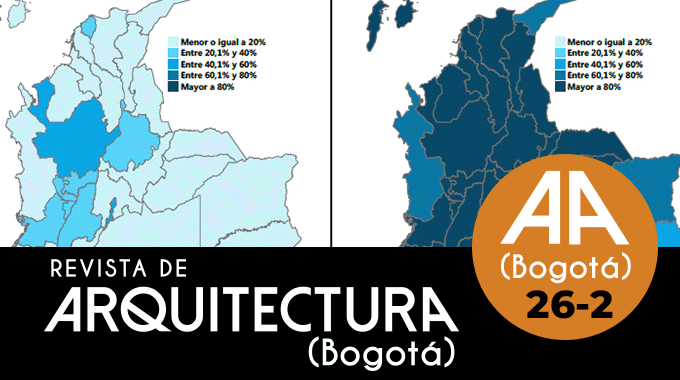

This work is licensed under a Creative Commons Attribution-NonCommercial 4.0 International License.
Revista de Arquitectura is an open access journal. More information...
Authors retain copyright and grant to the Revista de Arquitectura the right of first publication, which will be simultaneously subject to the Creative Commons (CC) BY-NC license.
Authors will sign a non-exclusive distribution license for the published version of the article by completing (RevArq FP03 Permission to Reproduce).
Self-archiving will comply with SHERPA/RoMEO guidelines and the Green classification.
To see in detail these guidelines, please consult...
Abstract
The research focused on developing a mobile application to understand and synthesize relevant bioclimatic strategies for architectural composition in academia, targeting university students as the primary audience. A mixed methodology was used, beginning with a qualitative approach to identify pertinent topics, followed by a quantitative approach to determine how technologies
are used in academia. The choice of a mobile application was based on the need to gradually introduce students to bioclimatic topics, avoiding complexity and excessive volume of suggested topics. Essential themes such as air, sun and water were selected for inclusion in the application, aiming to align them with the social nature of the students and allow for future updates and adaptation. In summary, the goal was to develop a flexible and adaptable mobile application that enables university students to acquire knowledge about bioclimatic topics and use it both inside and outside the classroom throughout their careers.

References
Cedeño, A. (2010). Materiales bioclimáticos. Revista de Arquitectura,12(1), 100-110. https://revistadearquitectura.ucatolica.edu.co/article/view/760
Consejo Profesional Nacional De Arquitectura y sus Profesiones Auxiliares, CPNAA. (2018) Caracterización del arquitecto en Boyacá. (1. ed.) Tunja. CPNAA. https://www.cpnaa.gov.co/perfil-del-arquitecto-colombiano-boyaca/
Consejo Profesional Nacional de Arquitectura y sus Profesiones Auxiliares (CPNAA). (2019) Perfil del arquitecto colombiano (1ed.) https://www.cpnaa.gov.co/wp-content/uploads/2020/06/PRESENTACION-CPNAA-CARACTERIZACION.pdf
Departamento Administrativo Nacional de Estadística (DANE). (2019). Boletín técnico / Indicadores Básicos de Tenencia y uso de Tecnologías de la Información y Comunicación – TIC en hogares y personas de 5 y más años. (2da.ed). https://www.dane.gov.co/files/investigaciones/boletines/tic/bol_tic_hogares_2019.pdf
El Tiempo. (2017). Vida social, en lo que más usan los colombianos el celular.https://www.eltiempo.com/tecnosfera/novedades-tecnologia/uso-del-celular-y-el-internet-en-colombia-149384
Fundación Compartir, & CPNAA. (2019). Estudio sobre dónde está el mayor número de arquitectos en Colombia. https://fundacioncompartir.org/noticias/estudio-revelo-donde-esta-mayor-numero-de-arquitectos-colombia
Gutiérrez Rodríguez, H. (2016). Arquitectura Bioclimática: pautas para la composición de alternativas espaciales para el bien-estar en la vivienda. (1era ed.) Unal Ed. https://repositorio.unal.edu.co/handle/unal/57898
Línea Verde Ceuta. (2019). ¿Qué es una APP? http://www.lineaverdeceutatrace.com/lv/consejos-ambientales/apps-ambientales/que-es-una-app.asp
Mesa, M. L., Pinilla, M. E., & Piaggio, J. M. (2018). Proyecto educativo del programa (Pep) Facultad de Arquitectura, Diseño y Urbanismo (Fadu) Programa de Arquitectura. Ediciones Universidad de Boyacá. https://www.uniboyaca.edu.co/sites/default/files/2018-09/PEP%20ARQUITECTURA.pdf
MinTIC. (2018). ¿Cuáles son las redes sociales que más se usan en su región? Facebook y WhatsApp son las más usadas a nivel nacional, según MinTIC. https://www.mintic.gov.co/portal/inicio/Sala-de-Prensa/MinTIC-en-los-Medios/70369:Cuales-son-las-redes-sociales-que-mas-se-usan-en-su-region
Sistema Nacional de Información de la Educación Superior (SNIES). (2018). Información Poblacional - SNIES. https://snies.mineducacion.gov.co/portal/consultaspublicas/content/poblacional/index.jsf
Universidad Santo Tomás Seccional Tunja. (2018). Instrumento de caracterización neotomasinos. Ediciones USTA. https://santototunja.edu.co/comunicados/item/2690-instrumento-de-caracterizacion-de-neotomasinos-pregrado-tunja
Universidad Santo Tomas Tunja. Claustro estudiantil 2020-I Facultad de Arquitectura. Claustro Estudiantil Lectio Inauguralis. Tunja [Presentación, 78 diapositivas]. https://www.santototunja.edu.co/presentacion-arquitectura#perfil-de-formacion
































